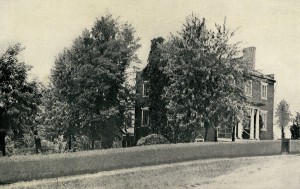Samuel Pleasants Hargrave is a signer of the fee bill with no apparent connection to the University of Virginia, either as a student or a professor. He was born in Virginia in either 1795 or 1796 and in his 52nd year was the second oldest signer of the fee bill.1 Much of what is known of Dr. Hargrave is from a book by Sara Rice Pryor entitled, My Day; Reminiscences of a Long Life. Born in 1830, Pryor wrote that she had many siblings, but an aunt and uncle who had no children. At the age of three and a half she went to live with that couple, Samuel Pleasants and Mary Rice Hargrave who resided in Hanover, Virginia, “… except for the three summer months, when it was his invariable rule to visit Saratoga, or the White Sulphur, Warm, and Sweet Springs, of Virginia ….2 The Hargraves moved from Hanover to Charlottesville, a distance of about 70 miles, for the benefit of Sara’s education when she was nine which would have been around 1839. Eager to continue Sara’s exposure to the broader world, the Hargraves took her to New York City and Niagara Falls when she was fifteen.3 Pryor expounded on the extensive hospitality of the Hargraves and wrote that on the occasion of any large religious, political, or literary gathering in Charlottesville her aunt and uncle opened their home to guests.4
Pryor gives us a glimpse of medicine as practiced in the mid 1840’s because she wrote about her interest in her uncle’s office work. “Physicians compounded and prepared their own prescriptions sixty-five years ago. He delighted in me when I donned my ample apron and, armed with scales and spatula, gravely assumed the airs of a physician’s assistant. I knew all his professional manoeuvres to satisfy hypochondriac old gentlemen and nervous old ladies. I learned to make the innocuous pills which ‘helped’ them ‘so much,’ and the carminative for the aching little stomachs of the babies.”5
Sara described Dr. Hargrave as a “wise man from the country” who had “given freedom to inherited slaves.”6 He was also a staunch Presbyterian and a supporter of Henry Clay and the Whig party which functioned for several decades before internal division about the expansion of slavery in the territories caused its demise. Convinced that Clay would be the next president of the United States, Dr. Hargrave took his young niece to Richmond so she could get a glimpse of him.7 Hargrave was one of the representatives of the Committee of Citizens of Albemarle which received a letter in 1847 from Clay thanking the organization for its invitation to come to Charlottesville.8
In the 1850 census, Dr. Hargrave’s occupation was given as a farmer; his real estate was valued at $4,500; and his household included his wife as well as Sara Pryor, her husband of several years, Roger, and a child.9 From 1853 to 1863 Dr. Hargrave owned “Rock Hill,” a 70 acre farm that was outside the corporation line of Charlottesville by about half a mile. His property included a six-room house, a separate kitchen and a house for “servants.” In 1860 he advertised his Rock Hill farm stating, “The undersigned is generally at home, and will take pleasure showing the place to such as wish a desirable farm and pleasant residence.”10 It took several years for Dr. Hargrave to sell, but he did manage to do so before the outbreak of the war. The current Rock Hill estate consists of 8 acres of extensive rock gardens, minus the circa 1820 Federal style house which burned down in 1963. It is owned by the Monticello Area Community Action Agency, and there is hope that the gardens might be restored and added to the Charlottesville city park system.11 Dr. Pleasants is not listed in Wood’s necrology which goes through 1890 when Dr. Pleasants would have been in his mid-nineties, if living, so it is presumed that he left the Charlottesville area.
- U.S. Census: Albemarle, Virginia, 1850, accessed 23 March 2011. [↩]
- Sara Pryor, My Day: Reminiscences of a Long Life (New York: Macmillan, 1909), 7, 9. [↩]
- John C. Waugh, Surviving the Confederacy: Rebellion, Ruin, and Recovery: Roger and Sara Pryor during the Civil War (New York: Harcourt, 2002), 325. [↩]
- Pryor, 65. [↩]
- Pryor, 70-71. [↩]
- Pryor, 38. [↩]
- Pryor, 34-35. [↩]
- Henry Clay to Messrs. Carter, Hargrave, Cochran, Magruder, Watson, Southall and Timberlake, 17 August 1847, Box 2:97, Papers of Henry Clay, Special Collections, University of Virginia Library. [↩]
- U.S. Census: Albemarle, Virginia, 1850, accessed 23 March. [↩]
- Rock Hill, Box 19, Papers of K. Edward Lay, 12817-a, Special Collections, University of Virginia Library. [↩]
- Dave McNair, “Rock Hill Forever: Charlottesville’s Not-So-Secret Garden,” The Hook 10, no. 27 (7 July 2011 – 13 July 2011): 17-22, accessed 26 July 2011. [↩]


